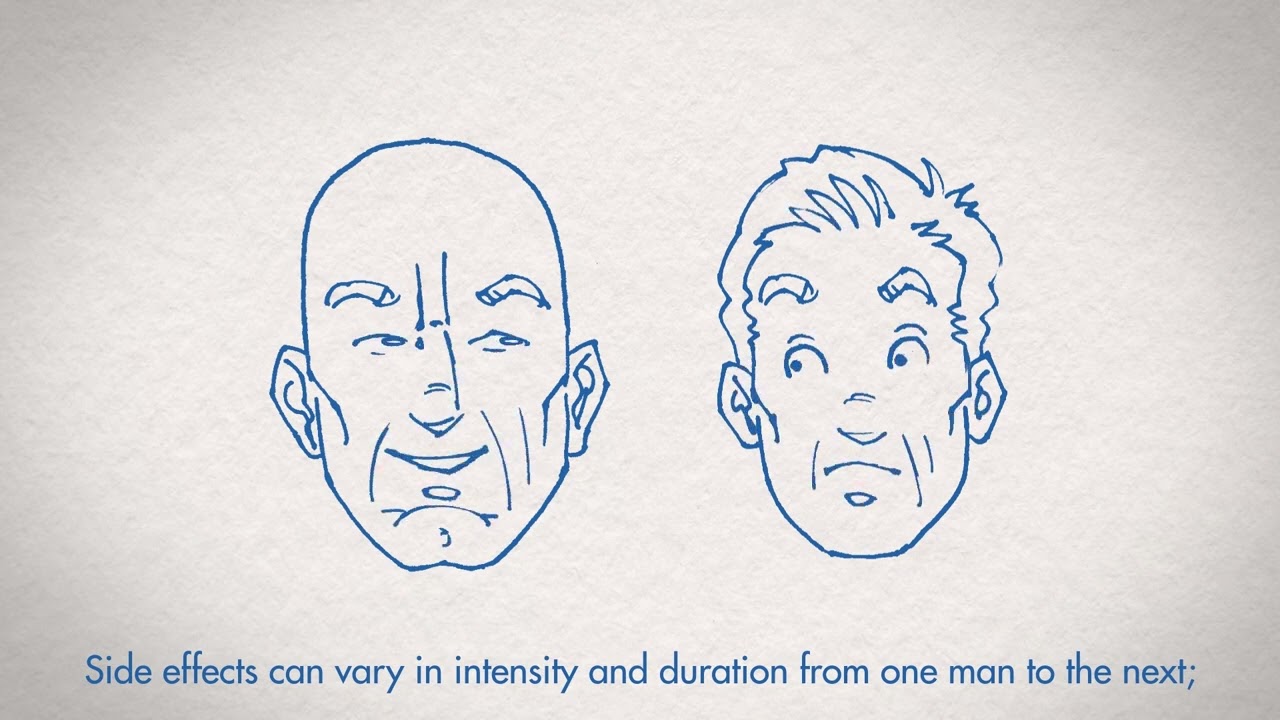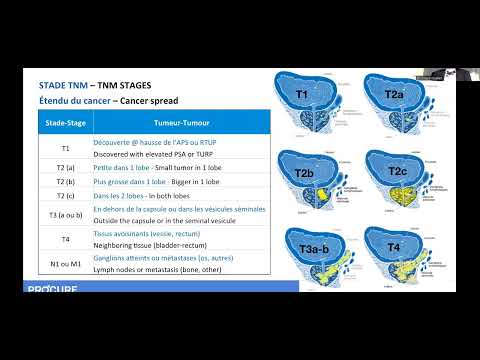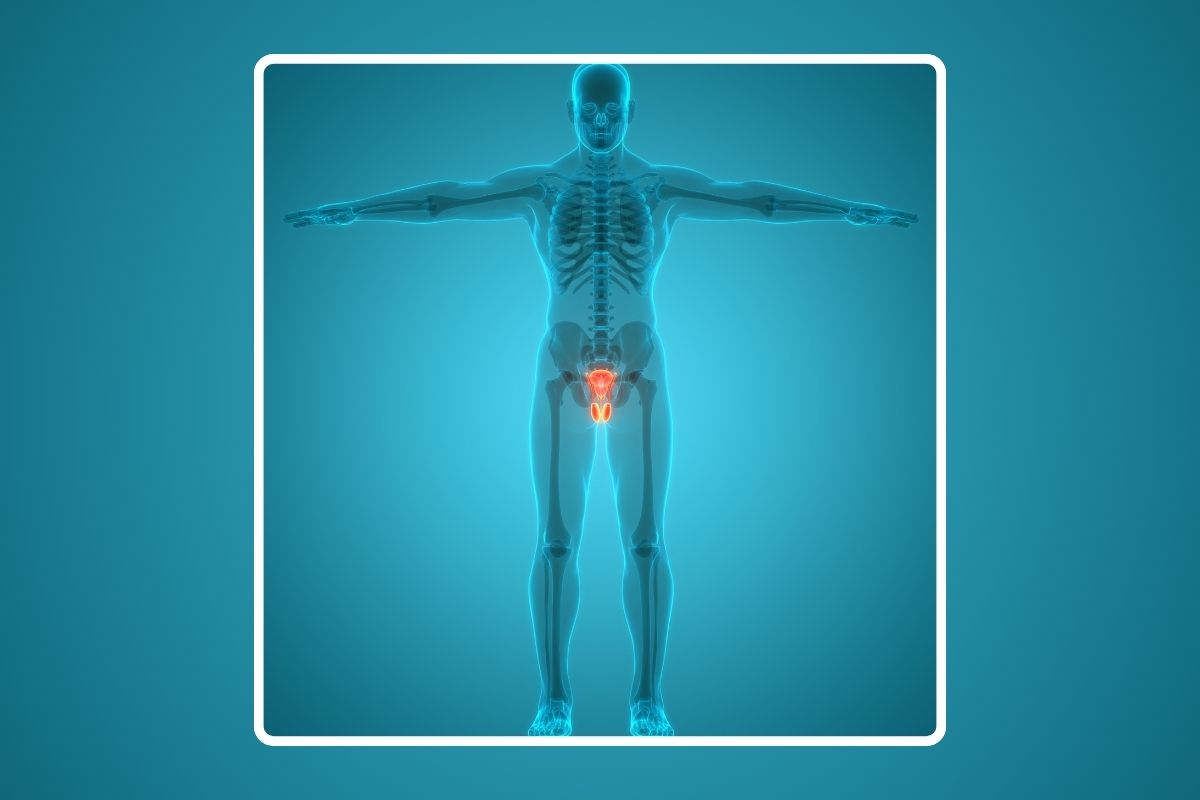Frequently asked questions
Frequently asked questions
This FAQ gathers the questions that most men have at the time of diagnosis. This website and our webinars, led by experts and available on our YouTube channel, can help you make an informed decision about your treatments or the path ahead of you.
Risk factors
The prostate is an organ of the male reproductive system. It is a walnut-sized sexual gland that enlarges in the late forties. It is located below the bladder and in front of the rectum. This gland surrounds the urethra, which is the tube that carries semen and urine from the bladder to the tip of the penis.
The main function of the prostate is to produce a whitish fluid called prostatic fluid, one of the components of semen. Due to its location, any changes in the prostate can affect urinary flow. Additionally, the prostate produces a protein called prostate-specific antigen (PSA).
The exact causes of prostate cancer remain unknown. Research suggests that men at higher risk of developing this cancer include:
- those over 50 years old (45 years @ risks) as the risk increases with age
- those with a family history of cancers (father-mother-brother-sister)
- those of African descent (black men)
The following factors may also have an impact:
- those with defective or inherited genes
- a diet rich in red meats, animal fats, or processed fats
- a deficiency in vitamin D and other supplements
- being overweight or obese
- exposure to pesticides or toxic chemicals/substances
No. However, men whose immediate family members have had prostate cancer are at least two to five times more likely to develop such cancer than those who do not have these family histories. For more information, see the Screening section: Is it for you?
At age 45, they should discuss screening with a family doctor. For more information, see the Screening section: Is it for you?
Screening
The digital rectal exam is a physical examination of the prostate through the rectum. After inserting a gloved finger into the rectum, the doctor feels the prostate to detect any lumps or abnormalities.
The analysis of prostate-specific antigen is a blood test that measures the concentration of PSA, a substance produced by the prostate. PSA levels vary with age and with the volume of the prostate. Many prostate problems, not just the cancer, can cause an increase in PSA levels. Sometimes men with prostate cancer have PSA levels considered normal. See All about PSA.
The PCA3 test is a urine test using a genetic marker that detects gene “Prostate Cancer Gene 3” (PCA3) involved in the development of prostate cancer. This is not a commonly used test.
The magnetic resonance image (MRI) is a test used in uncertain cases, that is to say when the PSA rate is high and the biopsy results are negative for example.
Diagnosis
If an abnormal result is detected with one of these tests, further analyses will be conducted to determine if it is cancer or another health issue. The additional analyses include:
- Repeat assessment of PSA levels. Therefore, more than one PSA test is always performed before proceeding.
- Transrectal ultrasound: an imaging device inserted into the rectum that uses sound waves to create an image of the prostate and neighboring organs, through the rectal wall.
- Prostate biopsy: sampling of prostate tissue (6 to 24 samples) using 16-18G caliber needles, which are then prepared for microscopic examination for pathological analysis.
Mild bleeding in the stool and urine may occur for a few days after the biopsy. The color of semen may be altered for several weeks after the procedure. Antibiotics prescribed before the procedure are intended to reduce the risk of infection. Prostate infection after a biopsy is rare. However, prostate infection is still possible and occurs in 2 to 4% of patients. Antibiotic treatment may be necessary if there is pain when urinating. If a fever develops after the biopsy, 38.5°C or higher, you should go to the emergency room. Treatment should be initiated promptly. Finally, it is recommended to avoid exercising for 48 hours after the procedure.
Most often, prostate cancer, especially in its early stages, can develop without any signs or symptoms. In some cases, symptoms may appear if the tumor abnormally enlarges the prostate. This exerts pressure on the urethra, similar to benign prostatic hyperplasia (BPH). Most urinary symptoms are due to BPH. It is RARE for prostate cancer to cause such symptoms.
Benign prostatic hyperplasia (BPH) is a non-cancerous enlargement of the prostate volume. Prostate volume enlargement is a phenomenon that occurs with aging in most men and can cause urinary symptoms. Prostatitis is an infection or inflammation of the prostate. Prostatitis can significantly increase PSA levels. Some men with urinary problems suffer from acute or chronic prostatitis. Both forms of prostatitis can be treated with antibiotics. For more information, see the Prostate Diseases section.
Treatments
It involves completely removing the prostate. This is the surgical removal of the prostate, seminal vesicles, and part of the bladder neck. The surgeon usually attempts to preserve the nerve and vascular tissues necessary for a good erection. They may also remove certain pelvic lymph nodes and check for invasion. Prostatectomy can be performed through open surgery (with an incision at the lower abdomen) or laparoscopically (with very small incisions to insert only the instruments). Laparoscopic or robotic techniques are less invasive than conventional surgeries.
This is an alternative to open surgery and simple laparoscopy. This procedure uses laparoscopic techniques, but with the addition of the da Vinci® surgical robot system, designed to allow surgeons to perform complex and delicate interventions in a minimally invasive manner.
As the name suggests, the goal of radiotherapy is to irradiate all prostate cells to eradicate cancer cells while preserving normal prostate cells. It is often used alone or in combination with hormone therapy or temporary brachytherapy. It is also indicated after surgery if there is evidence of residual cancer cells at the surgical site or in cases of post-surgery recurrence.
Brachytherapy for treating prostate cancer can be applied either by permanent implantation of radioactive seeds or by temporary placement of radiation emitters. Permanent seed implantation is suitable for patients with localized tumors and good prognosis for cure. It has been shown to be a very effective treatment for cancer. The procedure can be performed quickly. Patients are usually able to go home the same day of treatment and return to their normal activities after a few days. Permanent seed implantation is often a less invasive treatment option compared to surgical removal of the prostate.
It involves blocking “male” hormones responsible for tumor development. The modalities of hormone therapy vary. Hormone therapy is particularly relevant for older men and men with extensive cancer with or without metastases. Prostate cancer usually responds well to hormone therapy.
It involves destroying cancer cells. Chemotherapy mainly concerns patients with prostate cancer with metastases
Side effects
Due to the treatment itself and the daily travel required, fatigue is the most common side effect. Patients sometimes complain of lack of energy, which usually occurs after the second or third week of treatment. Energy gradually returns after the end of treatment. Each patient reacts differently to treatment; therefore, side effects vary from one patient to another. One may experience no side effects while another may experience several. For more information, see the Side effects section.
It depends on your energy level and the physical demands of your job. Remember that treatment and daily travel will require you to rest. The less energy you expend, the faster you will recover. It is always best to consult your radiation oncologist or nursing staff.
As a general rule, this is not possible because radiation leaves scars around the prostate, making surgery more difficult and risky. Nevertheless, in rare cases, surgery can be performed after radiation therapy.
The radioactive seeds implanted in your prostate are very small and you cannot feel them. They cause no discomfort and can remain safely in your body for the rest of your life. They remain radioactive for about a year, with their intensity decreasing over time. Pregnant women should stay one meter away from the patient for the first three months after seed implantation, while young children are not at risk. However, during the first three months, a child under twelve should avoid sitting on the patient’s lap for extended periods. If you plan to travel outside the country, a letter from your doctor explaining the radiation trace would be recommended.
Here are some possible side effects: hot flashes, decreased libido leading to erectile problems, swelling or tenderness of the breasts, osteoporosis (the treatment reduces bone density, leading to bone fragility and risk of fractures), weight gain, and loss of muscle mass. Each patient reacts differently to treatment; therefore, side effects vary from one patient to another. One may experience no side effects while another may experience several. For more information, see the Side effects section.
The side effects of chemotherapy vary depending on the chemotherapy or hormonal agent used in combination and the patient. Generally, damage to rapidly multiplying cells is responsible for some side effects. For more information, visit our side effects section or chemoready.ca, a specialized website on the subject.
Urinary and erectile disorders
Urinary stress incontinence occurs:
- either due to damage to the sphincter during surgery, resulting in sphincter insufficiency and loss of control of urethral closure;
- or due to bladder instability, leading to a disorder in the muscular contraction of the bladder.
Several factors have been implicated in increasing the risks of incontinence before surgery:
- patient continence before surgery
- the older the patient, the higher the risks
- a history of transurethral prostate surgery before radical prostatectomy
- the stage of cancer progression, as surgery is more extensive if cancer is advanced, which can affect the sphincter
- the surgical technique adopted by the surgeon
Urinary stress incontinence after prostatectomy varies from individual to individual. Urine loss can be substantial for some but minor for others. Urine leaks often occur late in the day and are triggered by exertion or fatigue. They usually diminish over time in the majority of cases but may be permanent in a small number of patients (5-10%).
Perineal rehabilitation before or after surgery may be effective in reducing urinary incontinence following prostatectomy. After the procedure, once the catheter is removed, most patients experience some lack of control over their urine output. Muscles strengthen within 2 to 4 months, and most men regain continence afterward. You can find products in pharmacies, such as underwear or pads, that you can use for protection. They are discreet and comfortable without being too bulky. After surgery, you can also perform certain pelvic muscle strengthening exercises, called Kegel exercises, to combat incontinence. When incontinence persists, other treatments such as biofeedback exercises are available. For more information, see the Side effects section.
Perineal rehabilitation remains the cornerstone of treatment. Surgical treatment is a last resort if rehabilitation fails. Sub-urethral tape is indicated for mild to moderate incontinence, while an artificial sphincter is best suited for severe incontinence after total prostatectomy. For more information, see the Side effects section.
Prostate cancer treatment causes changes in overall sexual function and particularly in erectile function. It is important to keep in mind that the younger you are, the better your chances of resuming erections after prostate cancer treatment. However, if you already have sexual dysfunction before treatment, it will usually be exacerbated by the treatment. Nevertheless, it is often possible to remedy or improve it after the intervention. For more information, see the Side effects section.
Other pages that might interest you
Additional Information - Your team and questions

Urologist’s advice: Treatments and information on prostate cancer
Learn more about the role of the urologist and the importance for a patient to gather adequate information after receiving a prostate cancer diagnosis.

How I coped with prostate cancer
A man with prostate cancer shares the challenges of his cancer experience.

Your role as a patient
You’ve been diagnosed with prostate cancer? Your role is as important as that of your medical team.

Diagnosis and treatment
Recently diagnosed with cancer? Educate yourself to fully understand your situation.

Everything to know about radical surgery
Considering radical surgery for your cancer treatment? Watch this webinar to learn about the procedure, its benefits, drawbacks, and suitability for you.

Urinary and sexual problems after treatment
Prostate cancer treatments can lead to side effects, such as erectile dysfunction and urinary incontinence, which vary in intensity and duration.

Surveillance, surgery or radiation therapy?
Diagnosed with prostate cancer? Several treatment options are available based on the stage, age, and your health.

Active surveillance as a treatment option?
Did you know that in many cases it is not necessary to treat prostate cancer?

Understanding HIFU treatment for localized prostate cancer
HIFU treatment (High-Intensity Focused Ultrasound), a type of focal therapy, is an innovative approach for treating intermediate-risk localized prostate cancer that is well-visualized on MRI. Although widely used globally, mainly in private clinics or within strict research frameworks, it remains relatively uncommon in Quebec and Canada. It is not yet recognized as a standard treatment […]

I have 4 treatment options; confused, you say?
If being diagnosed with prostate cancer is a massive blow for men, the treatment options can quickly become a headache…

Me a guinea pig?
Did you know that participating in a clinical trial advances medical science and improves the lot of patients for future generations?

Active surveillance in 5 points
As surprising as it may seem, your doctor may prefer to wait before starting treatment.

If I had been given the choice
If I had been given the choice, I would have opted for active surveillance! Rest assured that if your prostate cancer has little risk of progressing and you are a good candidate, the active surveillance option will be offered to you. Indeed, in many cases, it is not necessary to treat this type of cancer. […]

The importance of medical monitoring
Have you been or are currently being treated for prostate cancer? In such a case, it pays to know the facts to fully understand the importance of medical monitoring. After a diagnosis of cancer, you will normally be followed by your urologist for several years. Depending on your type of cancer and treatment, this follow-up […]

Why am I receiving hormone therapy?
Why am I receiving hormone therapy? Has your doctor recommended hormone therapy to treat your prostate cancer? Prostate cancer is a hormone-sensitive type of cancer, meaning its development is stimulated by male hormones: androgens and, more particularly, testosterone. Hormone therapy works by preventing your body from making or using these hormones, which stops your cancer from growing […]

Prostate cancer: Advances in radiation therapy
If you have been diagnosed with prostate cancer, your doctor will consider many factors before recommending the best treatment. For many of you, this may mean external and/or internal radiation therapy. There are also advances in radiation therapy. These include more sensitive and specific functional imaging called PET PSMA, new and more effective hormone therapies, […]

Permanent brachytherapy: What exactly is it?
Permanent brachytherapy often called low dose rate brachytherapy, administers very small doses of radiation. They are emitted from small sources containing radioactive iodine, called “iodine 125”. These sources look like grains of rice. They stay in your prostate forever. However, their radioactivity decreases over time. After 6 months, 95% of the radioactivity has disappeared. The presence of these sources does not cause any long […]
Sources and references
Last medical and editorial review: April 2024. See our web page validation committee and our collaborators by clicking here.


